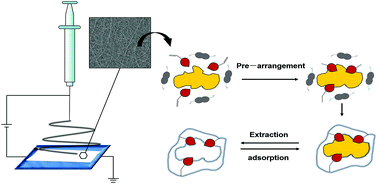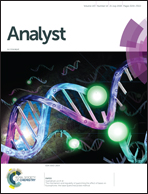Molecularly imprinted electrospun nanofibers for adsorption of 2,4-dinitrotoluene in water†
Abstract
The detection and adsorption of nitroaromatic compounds such as 2,4-dinitrotoluene (DNT) is of great importance, but the selective detection of trace DNT in water remains a challenge. Here, we report molecularly imprinted polymer (MIP) nanofibers fabricated by electrospinning using DNT as a template molecule and poly(allylamine) as a functional macromer. The physical and chemical properties of the nanofibers were characterized by Fourier transform infrared (FTIR) spectroscopy, X-ray photoelectron spectroscopy (XPS), and scanning electron microscopy (SEM), and the DNT adsorption and selectivity properties were also studied by high performance liquid chromatography (HPLC). The results show that the nanofibers prepared using 20 wt% poly(ethylene terephthalate) (PET) in solvent had a good morphology and an optimal ratio of poly(allylamine) and DNT, and the imprinted nanofibers showed specific adsorption of DNT, in accordance with the Freundlich isotherm model and Scatchard analysis. Furthermore, the imprinted nanofibers showed remarkable stability and reusability, losing only 3% of their performance after eight cycles. Thus, the imprinted nanofibers fabricated by this strategy could be used for trace DNT extraction, separation, and further construction of sensors in the near future.



 Please wait while we load your content...
Please wait while we load your content...